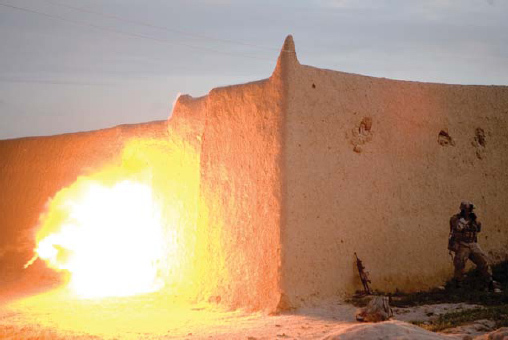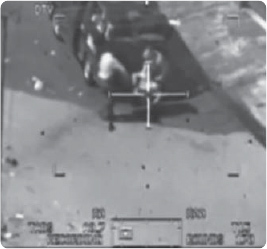Pointers for staying alive in urban warfare
Given you cannot always use an air strike or artillery to flatten the place here are some tips: To clear a whole building start at the top, if you can, and work down so that you can drop
grenades down the stair-well ahead of you if required.
To clear a room, toss in a grenade through the window if you have to approach from ground level. If not, shoot up or down through the floorboards before throwing in a grenade. If it seems sensible, have someone outside with a grenade launcher lobbing in the grenades through the window while another team, with careful timing, clears the rooms. If you open the door to toss in a grenade someone will shoot you through the door.
If you have the knack, time your grenades to explode in the air for best effect. The flash, bang and shrapnel from the grenade will stun anyone in the room long enough for you to walk in and finish them.
On entering a room, if you are using a rifle aim for the centre of the body for a sure kill. If you are using a pistol or SMG aim for the head if they are not moving otherwise the body first then the head as they may be wearing body armour as underwear.
If you are fortunate, you may be issued with some handy little explosive charges called ‘door knockers’ by the British on the basis that they get doors open. Sometimes doors are remarkably difficult to kick in. And even when they are not, would you really want to be kicking a door with an armed enemy on the other side? If it were me I would shoot you through the door. Place one of these charges against the door and set them off then follow up with a grenade to make sure. The door will blow inwards and the noise will help pacify the occupants. The US Army have a whole series of useful toys from special rifle grenades and heavy duty shotguns to tailor-made explosive charges. Don’t you just love American kit?
REMEMBER:
If you run into a room with a gun, the person already inside has the advantage and, if they are not stunned or timid, they will kill you before you get a bead on them.
If there are ‘innocent’ civilians inside the chances are that a grenade will do them no permanent harm but when you enter do be careful not to leave a bad person alive just because they are female – there are plenty of armed and dangerous female insurgents.
Tactics of the future
As technology develops we are going to be issued more advanced robotic weapons. Tactics will be modified to keep pace and hopefully keep us alive longer. Already we are starting to see a situation where infantry work as spotters to call in fire from air and artillery when they find the enemy.
And we all know about the armed drone aircraft such as the Predator and the Reaper which are flown from bases in the States and are being used to target the bad guys behind enemy lines without risking our pilots. And robots which creep up on bombs and disarm them have been around for decades.

This is how to open a door – there is no need to be polite. (Corbis)
Within a few years we will be supplied with their grandchildren: there are already ‘drone’ armoured vehicles in testing. Effectively these are small tanks armed with roller cannon which can either be controlled from base or can ‘think’ for themselves. Does anyone else find that a bit spooky? I have seen these and they look like something from a science fiction movie. The thing is though, they kill the enemy without exposing you to fire. That can only be a good thing.
I can see tactics evolving where there are actual patrols of these ‘ground drones’ working across the countryside in Afghanistan and elsewhere. Back at base, in the States or wherever, each vehicle would be operated by a commander, a driver and several gunners all sitting at computer screens in a shed and playing what look like computer games. Very much like what the air drone pilots do now. At this point we are un-killable as there are no men involved on our side yet the land drones can do everything a vehicle patrol can. They could, theoretically, even speak with the locals over a video link. I am developing the tactics for use with ground drones.
I have seen a robot sentry gun turret manufactured by a South Korean firm which is a step on from the radar-controlled roller cannon used currently to shoot down rockets and shells approaching ships and our larger land bases. This robot gun turret mounts a .50cal Browning – though it could be a GMG or any cannon – and watches its target arc for enemies using light, infra-red and other sensors to detect humans or moving enemy assets. Then, when it sees something it doesn’t like the look of, it opens fire without a human operator. And then it corrects its fire until it hits the target. I saw one of these destroy high-speed boats approaching the shore and targets on land. This is the future.
TACTICS FOR THE ATTACK: DESTROY THAT ENEMY BASE!
We have now looked at the principle ways of attacking the enemy and I hope I have made the important points clear to you so that you understand what is required and can either put a reasonable plan of attack together; or at least understand and follow someone else’s plan intelligently.
It is my belief that if everyone involved in an operation understands what the objective is and how it is going to be achieved then this makes all ranks more motivated and, given how often things go wrong in the face of the enemy, more able to find other ways of achieving the same overall objective. Of course, you can only tell your men what is happening so far as is possible given security and other constraints. You wouldn’t want someone who may be captured knowing your long-term plans would you?

Don’t be a hero, call in the big guns of aerial support when you can: gunner’s camera on an Apache attack helicopter. Lurking high in the dark sky and some kilometres away it can easily destroy individuals on the ground. (Corbis)
As I have said before, some people learn best by being told how things work, some learn by remembering all the facts and some people learn best by seeing a working example. To try to cover all our option here I shall finish off with a little story about a fictional attack on an enemy position. It will seem a little ‘busy’ but I have tried to involve as many of the options and possibilities as I could so you will see where they all fit in.
The standard format for a mission briefing, as I have shown previously, is GSMEACS – Ground, Situation, Mission, Enemy forces, Attachments and Detachments, Commands and Signals. Don’t think I have forgotten, but some of this standard information is irrelevant here as this story is more than a briefing and continues through the actual contact to the end of the mission.
The situation
The Western Alliance is occupying a country similar to Afghanistan on the pretext that we are bringing freedom, democracy, education and the emancipation of women to the locals while preventing Islamic insurgents and extremists from training and organizing attacks on Europe and the USA. We will refer to the country we are occupying as ‘Country A’.
While there is some definite truth in this we also intend to control an oil supply pipeline which runs westwards across the north of landlocked Country A to a West-friendly sea port in a neighbouring country and also gain access to strategic reserves within Country A which include 36 trillion cubic feet (1,000 km3) of natural gas, 3.6 billion barrels of petroleum and up to 1,325 million barrels of other natural gas liquids. Recent reports also show huge amounts of gold, copper, coal, iron ore and other minerals.